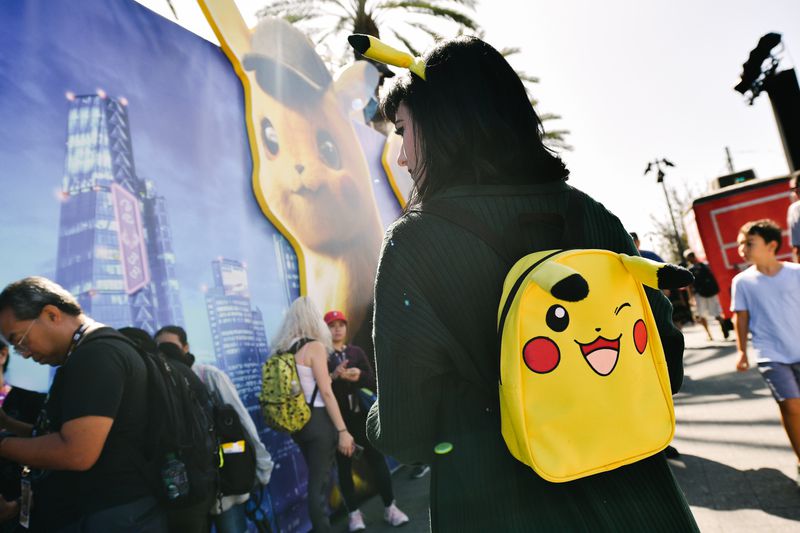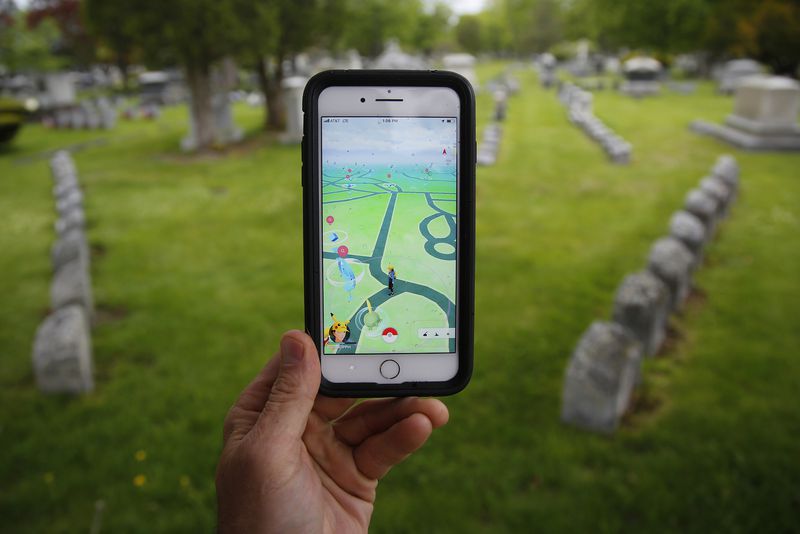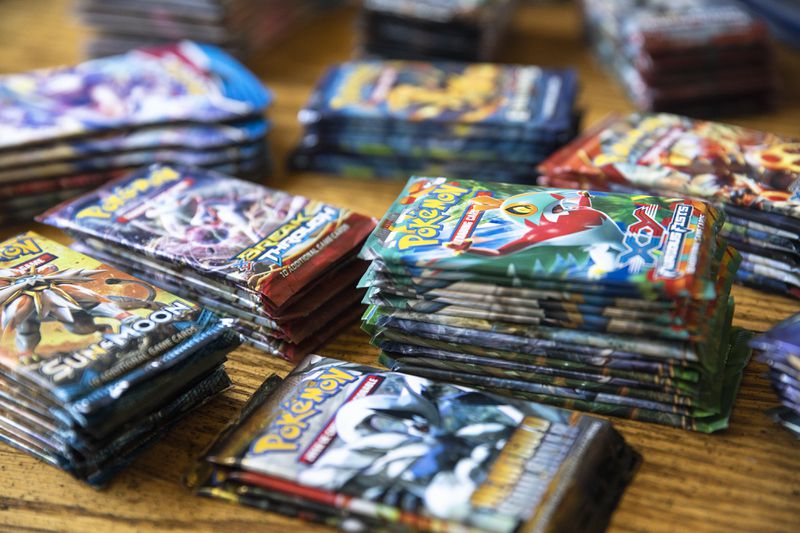
A wildly popular Nintendo franchise, Saturday morning cartoon, and trading card game, Pokémon had all the hallmarks of a flash in the pan. Two decades later, it’s a $100 billion empire.

Part of the Fads Issue of The Highlight, our home for ambitious stories that explain our world.
Pokémon wasn’t anywhere, and then it was everywhere.
If you were in grade school in the United States in 1998, you probably remember it clearly. Pikachus, Charmanders, and Squirtles stormed children’s entertainment, reshaping card shops, fast-food toys, and Saturday mornings in their wake. The theme song from the Pokémon TV series, colloquially known as “Gotta Catch ’Em All,” somehow reached No. 3 on Billboard’s US Dance Singles chart in 2000, not long after Pokémon: The First Movie opened in American theaters. (The movie made $10 million on its opening day.) Lunch hours at elementary schools turned into a Wall Street trading floor, as kids bartered, hustled, and haggled over newly minted trading card collections.
I haplessly handed over my binder to a fast-talking upperclassman, who sifted through my hoard of cards, commented on my good taste, and slyly plundered my stock before I knew what hit me. Within a week, the principal had banned Pokémon at my school, and my mom enforced a strict moratorium on all collectible cardboard in our household. It was an attitude common at the time, as American youths fell under the sway of the latest fad. Parents hunkered down and waited for Pokémania to blow over, because it always blows over.
So many elements of the craze reeked of a distinct, late-’90s tang, one that usually meant a short half-life. (A trading card game? Based on a Nintendo franchise? Accompanied by a Saturday morning serial?) In fact, from the very moment boys and girls started begging their parents for foil booster packs and the franchise drifted over from Japan as part of the great ’90s anime boom, journalists eagerly presaged Pokémon’s humiliating demise. “Beware of the Pokemania,” shouted a haughty Time cover story headline in 1999. “Parents who have had to suffer through the games, the TV series, and the shopping trips can take some comfort in the fact that the Pokémon demographic is the same one that has abandoned Teenage Mutant Ninja Turtles and Power Rangers.”
That thesis was elementally sound. Children are fickle, and fads are supposed to be temporary and facile. And yet, unlike all of the other signifiers of millennial jejunity — the Pogs, the Beanie Babies, the Furbies, the carpetbaggers like Digimon and Monster Rancher — the indomitable Pikachu clan has only grown more entrenched with time.
In many ways, the brand is bigger than ever. Pokémon currently reigns as the single highest-grossing media IP on earth, with revenue exceeding roughly $105 billion across those same movies, video games, and merchandise that Time carped about. (It’s a number that beats Star Wars, Harry Potter, and the Marvel Cinematic Universe.) Today, nearly 25 years after the initial craze, Pokémon cards set auction records. Most recently, a rare Charizard card sold for nearly $400,000, a figure that was inconceivable only a few short years ago. There were more than 1 billion downloads of the 2016 app-based phenomenon Pokémon Go, which used augmented reality to embed Pokémon in the real world; a reported 800,000 players remain active in the United States alone. In 2019, Detective Pikachu earned $433 million at the box office in the first live-action film based on a Nintendo property since 1993. The priggish hopes that another mania would quickly supplant Pokémon never came to pass.
In fact, the inaugural generation of Pokémon trainers are now in their 30s and 40s, and raising fans of their own. After more than two decades of tenacity, the Pikachu estate snapped a subtle tripwire between ephemeral trend and canonical pop culture. Pokémon is clearly here to stay.
Pokémon hasn’t changed much. In the first games of the series, 1998’s Pokémon Red and Pokémon Blue, players took control of a teen tasked with snaring and documenting the many different species of Pokémon native to a designated prefecture. (Franchise creator Satoshi Tajiri collected insects as a child, which he’s cited as a primary influence.)
Red and Blue were both developed by Game Freak — which develops the franchise for Nintendo — and in 2019, that same studio released Pokémon Sword and Pokémon Shield, the eighth generation of games in the franchise, which effectively keep the same formula. Once again, you leave home with a quest to catch all the creatures in a region. Once again, you’ll battle the friends and rivals you meet along the way. Once again, you’ll keep grinding until you alone reign supreme atop the Pokémon league.
The brand has never suffered a constitutional redesign or a temporal reboot or a harsh change in tone. The Pokémon animated series has banked over 1,000 episodes to date, airing in syndication with a continuous, unbroken narrative since 1997. The Pokémon Trading Card Game has never gone out of print, and today consists of 77 different English sets. Nintendo has made Pokémon a crucial pillar of its digital business to a nearly self-plagiaristic degree, remaking many of the older games in the series and re-releasing them with updated graphics and subtle improvements to a grateful contingency of fans. It never gets old.
Perhaps the first step in deciphering why Pokémon has been immune to the diminishing returns that plague the rest of children’s entertainment is to understand the simple fact that for many fans, Pokémon never disappeared. Empires rise, empires fall, and a fresh, but familiar, batch of new Pokémon content is forever on the horizon. The brand is dependable, like Thanksgiving food or a How the Grinch Stole Christmas screening on a frosty December night.
“I think what Pokémon does that few trends can do to sustain relevance is form a community. It isn’t just about the cards and the games, but it’s also about something more than that,” says Nir Eyal, a former Stanford marketing lecturer and author of Hooked: How to Build Habit-Forming Products. “When you think about the pet rocks in the ’70s or the fidget spinners of the 2010s, a community of people was never activated around them. But Pokémon engages people with things they can do together. All of the parts of the franchise have a social element. It’s a communal experience.”

Matt Winkelmeyer/Getty Images
Eyal’s theory will strike a chord with the Pokémon fans who, like me, were seduced by the universe as children and stuck around through college and adulthood. Maybe that’s due to the bright sheen of wide-eyed optimism streaking through the brand’s doctrine, especially when compared to the garish, raditude-heavy blitzes of other late-’90s ventures. (Seriously, go watch those old BeyBlades commercials.)
As Jeremy Parish wrote in his 2018 Polygon essay on the matter, Pokémon epitomizes “everything good and appealing” about video games. This was a land filled with safari adventures, backpacking trips, and the unifying power of teamwork. A central element of Pokémon is the ability to exchange your pet monsters with friends; back before you could accomplish the same results with a wifi connection, we’d link together our Game Boys with a plastic-encased wire and aid fellow trainers with the creatures we discovered on our respective journeys. It was a sensation that felt more like a system of beliefs than the machinations of a media franchise.
Gene Park, a gaming journalist at the Washington Post, says he believes that Pokémon has cultivated a subtle sense of timelessness — rapidly inaugurating the cast into the rare omnicultural space occupied by Bugs Bunny and Mickey Mouse. Pikachu and its cohorts possess a magic that transcends the cafeteria. Park’s not surprised that they stuck around.
“All of the Pokémon have different personality traits, so when you attach this beautiful design to these distinct temperaments, people become attached to them. It’s like owning a pet,” says Park. “It harkens back to the golden age of cartooning. You can always rely on Spider-Man to be trustworthy, and you can always rely on Pikachu to be cute and say, ‘pika pika.’”
Of course, nobody should discount Nintendo’s vested interest in maintaining Pokémania through all sorts of marketing tricks. Pokémon’s most famous catchphrase is, “Gotta catch ’em all” — the idea being that nobody could complete a Pokémon game until they owned every single creature in the lineup. This paired nicely with Game Freak’s strategy of consistently releasing two new Pokémon games at once — like the aforementioned Red and Blue — which each contain certain Pokémon that can only be obtained by either purchasing both copies or trading with someone. This same mindset trickles down into the regionally bound Pokémon lingering on the maps of Pokémon Go, which uses Google Maps-style geotagging to embed the world with all sorts of Pokémon hiding out in the streets of suburbia. Want to catch a Kangaskhan? Better book a flight to Australia.
In many ways, Nintendo has turned Pokémon into a closed-circuit commodity economy, wielding the eternal power of forced scarcity to keep the hunger alive. The moral panic that enveloped the first wave of Pokémon focused on the supposed baronial corruption of the youth. (“Grownups aren’t ready for their little innocents to be so cutthroat,” reads another line in that Time story. “Is Pokémon payback for our get-rich-quick era — with our offspring led away like lemmings by Pied Poke-Pipers of greed?”)

Derek Davis/Portland Press Herald via Getty
These concerns weren’t entirely invalid. I was far from the only kid to be conned out of my collection, and in 2021, as Pokémon cards reach increasingly ludicrous prices, there are mounting reports of chaos in department stores as flippers buy as many booster packs as possible with the hope of a lucrative eBay resale. This has led to a notable schism in the Pokémon community. Longtime fans are happy that the hobby has stayed relevant, but are troubled by the recent, single-minded emphasis on capital gains. In fact, some of them echo the same qualms voiced by those clueless, terrified parents 20 years ago. In a world where YouTuber and stunt-boxer Logan Paul is walking to the ring with a Charizard wrapped around his neck like jewelry, does Pokémon finally resemble the rapacious fad that reporters warned about 20 years ago?
“People who are genuinely interested in collecting Pokémon cards have a harder time finding them now,” says Dani Sanchez, a prominent Pokémon YouTuber in Los Angeles. “The flippers just want to make money from the resale, and that’s upsetting. It should just be a hobby. There’s a weird, looming negativity because of people in the community with an ulterior motive.”
It’s ironic that after more than 20 years as a dominant transmedia force, Pokémon is still vulnerable to the same manic capital psychosis that tends to accompany the earliest, wildest, and most unsustainable eras of a fad. Like me, Sanchez has loved Pokémon for most of her life, and I reckon that she also perceives the brand as chronically under siege. People of our stock remember the warmth of our ancient weekend afternoons, admiring our cards on the bedroom floor, while the authority figures in our lives reiterated to us that we were participating in a hobby that was foolish or nerdy or otherwise trivial. Deep down, we always knew that conclusion was wrongheaded, and that put Pokémon fans in a perpetually defensive position.
But oftentimes, those same fans can be toxic. There are countless incidents of Pokémon developers being harassed online due to seemingly unremarkable game design decisions. Most recently, Game Freak pared down the number of Pokémon available in Sword and Shield — instead of 898 creatures to collect, there would be only 400 — which resulted in a seismic controversy in the community.
It’s difficult for a layman to understand why anyone would issue death threats over the enumeration of Pokémon in a new video game, but that’s the ugly inevitability of a franchise that has made a point to preserve the world’s memories in amber. Every alteration Nintendo makes to the Pokémon brand stirs a primal instinct that has been dutifully groomed since Pikachu first ventured across the Pacific. Pokémon has broken into an ethereal space between brand and tradition — with just a few edits in the source code, a nation of adherents can immediately transport back to a most juvenile rage.
Some authorities in childhood development suggest, however, that Pokémon may a force for good (for me, it’s far too heartbreaking to imagine it as anything else). Joseph Tobin, an education professor at the University of Georgia and author of the (unfortunately titled) 2004 book Pikachu’s Global Adventure: The Rise and Fall of Pokémon, recalled for me a trip to a Toys R Us in the early 2000s where he analyzed the card-trading practices of the Pokémon-obsessed youth. He found no evidence of Pokémon’s supposed necrotic influence. Instead, Tobin describes a tiny, self-governing fiefdom unique to children of a certain age — a utopia built with Pikachus.
“We did the empirical work. There was very little evidence that Pokémon was being exploited by kids in a mean way more so than other toys,” says Tobin. “I’d buy cards and trade with the kids. And I was less aware of the value of the cards than they were, so I’d let them propose whatever trade they wanted. Some of them couldn’t believe I’d trade a holographic card, others would be like, ‘No, no, that’s not fair!’ Part of the fun for them was knowing the value. To be savvy. But that doesn’t mean you’re an evil venture capitalist. I think the kids are always interested in fairness and justice, more so than adults.”

Sara Stathas/Bloomberg via Getty Images
As the Pokémon generation entered their 20s and 30s, they discovered a will to consecrate the sentiment that Tobin identified. Those kids in the Toys R Us inherited the earth, and like all young adults, they found the agency to set their own precepts. The first task at hand? Establish once and for all that Pokémon is fun and good, and that all of the stigmas authored by those who did not live through the craze like they did were outdated. Pokémon never grew stale because ascendent millennials have validated their own memories. Our parents might’ve been right about Yu-Gi-Oh, Webkinz, and the starving Tamagotchis moldering in the basement. But they were wrong about this one.
That’s why hardcore lifers and star-crossed casuals alike fell for the Pokémon Go rage in 2016. That’s why Nintendo can count on an everlasting contingent of buyers for both the new Pokémon games and the ancient remasters pulled from the musty coffers. That’s why the value of those old trading cards continues to smash financial thresholds, rivaling every other investment property on the planet. Pokémon became a brand fans wanted to fight for.
You can chalk that up to the franchise’s genius character design or shrewd retail strategy, but I tend to think that every generation has a certain media diet that alters them in a nearly imperceptible way. I woke up at 6:30 am every morning to watch the Pokémon television series before going to school. I’d battle my friends over and over again on winter weekdays when the sun hung low, leaving our unfinished homework strewn across the dining room table. We spindle together those stories and recognize that they feel far more important to us than a goofy fad.
“The games change very little, so that when you feel the itch to go back to Pokémon after letting your interest lie fallow for a few years, it’s like returning to your hometown after spending time abroad,” writes Parish, in his Polygon essay. “Things look a little different here and there, but on the whole, it’s all pretty much the way you remember it. It becomes comfortable, and comforting.”
Jean-Marie Scheid, a 34-year-old in Washington State, is already nurturing the next generation of Pokémon fans. He spent his time on paternity leave with his newborn daughter wide-awake in the witching hour, desperate for anything to fill the void. Scheid stumbled on the Pokémon anime, which was available on Netflix. “Conditioning works, I guess,” he says with a laugh, noting that his 6-year-old daughter now takes a plush Pikachu with her wherever she goes. The brand’s magic worked on us as children, and it’s lost none of its luster as it trickles down to our inheritors. The cycle endlessly repeats, much like the Pokémon games themselves.
“At this point, I know that Pokémon will be around for my daughter’s daughter,” says Scheid. “It’s achieved that status. Will they be redoing the Marvel movies in 30 years? Yeah, probably, and Pokémon will be right there with it. Back in the day, when this first came out in the US, I never would’ve expected that.”
I will soon be the same age as my mother was when I was first taken by Pokémon. Already, I’ve become wary of the questionable fads galvanizing Gen Z — the metaphysical Roblox economy, the hypnotizing TikTok dances, the fictional influencers — stuff that gets written about in increasingly foreboding tones. All of them are alien to me, but I know my perspective doesn’t matter one bit. Eventually, the Zoomers will be old enough to experience the same cocktail of wistfulness and allegiance that I do when I look at an old Blastoise card. The kids always enshrine their own Pokémon, regardless of what the adults have to say.
Luke Winkie is a reporter from San Diego. He has written for Rolling Stone, GQ, the Washington Post, and the New York Times.
----------------------------------------
By: Luke Winkie
Title: Pokémon will outlive us all
Sourced From: www.vox.com/the-highlight/22825263/pokemon-nintendo-cartoon-card-game-longevity
Published Date: Mon, 20 Dec 2021 13:14:11 +0000
Did you miss our previous article...
https://consumernewsnetwork.com/politics-us/americas-forgotten-interior






